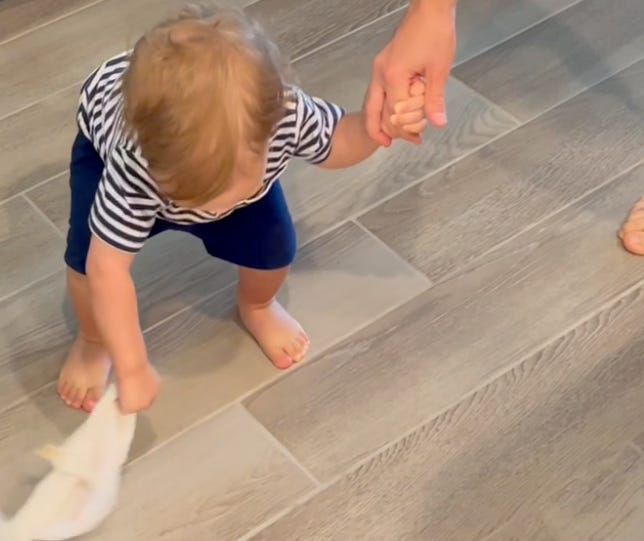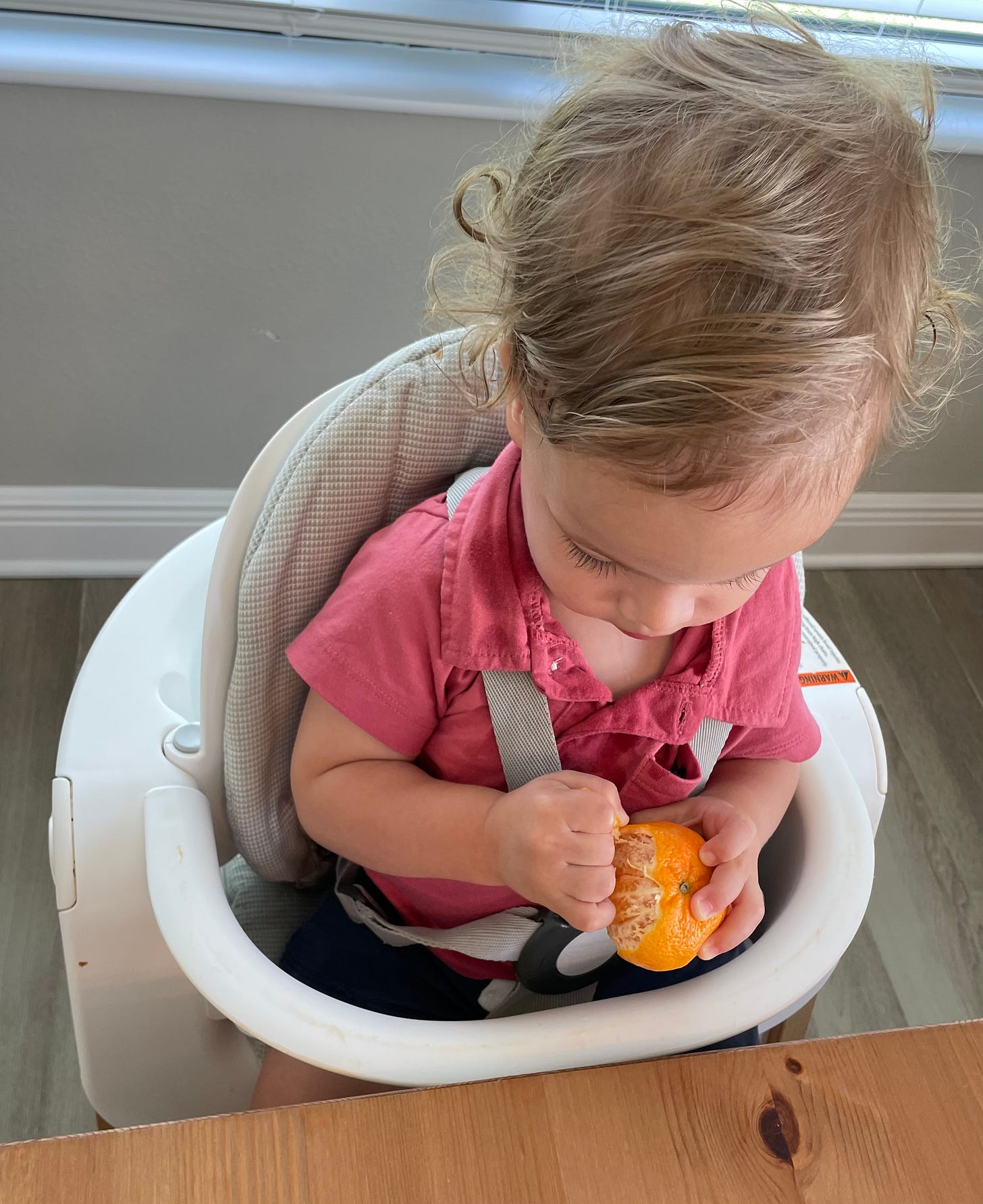The Practical Toddler
Edition 24: Build confidence, learn by doing, and become a contributing member of the family
Hayden, who’s a year old, picks up his dirty shirt and places it into the laundry basket in his room. He also wipes the floor when there’s a spill or mess and loves to peel fruit, like a clementine or banana, for his snack. Lately, he’s been working on slicing boiled potatoes in half.
You may think, “Oh, you have a little helper around the house!”
That’s one way to see it, and it’s a common reaction. But such a response looks at these kinds of scenarios from the parent’s point of view.
While having Hayden take care of his dirty laundry, peeling a piece of fruit for his snack, or taking a piece of trash to the trash can saves me from doing it myself, that’s not why I’ve introduced practical life activities to Hayden.
After all, I could do these things in a fraction of the time. But I’m not after efficiency.
Rather, I involve Hayden in many practical life activities for his benefit—not mine.
A Desire to Help
Around 11 months, Hayden began helping me with laundry. He’d do simple tasks, like open and close the dryer door, and push the “start” button on the dryer. Eventually, he helped me pull the laundry out of the dryer and into the laundry basket.
These are very basic tasks, to be sure. But his face lit up every time I said, “Hayden, I could use your help with the laundry. Can you please help me?”
After a few times, he knew exactly what I was saying. He crawled directly toward the washer and dryer with a big smile across his face. His facial expression said it all: he loved being involved. Fast forward several months and his enthusiasm for helping with laundry hasn’t waned. In fact, I’d say it’s increased.
As he’s gotten older, and his abilities and mobility have improved. So I’ve given him more responsibility, like taking the laundry from the washer and putting it (piece by piece) into the dryer.
I’ve also expanded the activities to involve him with. Around 12 to 13 months, Hayden began to take his dirty laundry to his laundry basket. He also began to help me clean up bits of food that fell to the floor during mealtime.
Three months on and the process hasn’t gotten old. I bring over the roll of paper towels; he rips one off; and we wipe up the mess on the floor. Then, we walk over to the trash can and drop it in. His face beams with pride the entire time.
Hayden is now 16 months. Over the past few months, he’s helped me with a number of other tasks around the house:
Filling up the watering can and watering the flowers
Peeling fruit
Slicing fruit, like bananas and avocados
Baking
Peeling hard-boiled eggs
Putting flowers into a vase
Wiping the table after a meal
Filling a container of water
Wiping the floor
As he gets older and more capable, I plan to increase the tasks and amount of responsibility with these activities and others. For example, once he gets a better grasp of colors and sorting he can help me sort laundry and fold it.
I Can Do It, Too!
The interesting thing is that Hayden loves to help. I can see it in his face and in the tenacity he applies to each practical life activity. He works as hard as he can, and confidence radiates from his little body once he completes a task, seemingly saying: “Look, I can do this, too!”
That’s a reason why I incorporate practical life activities: to build confidence. A way to build confidence is to do things yourself. It’s been true in my own life, too. My confidence gets a boost when I do new things on my own. A toddler is no different.
I want Hayden to learn that confidence comes from within: it’s internal, not external. And involving him in practical activities around the house is a way to implicitly teach this lesson.
I know Hayden feels great every time he picks up his t-shirt, walks over to his laundry basket, and drops it in. I don’t have to laden him with praise (external reward); completing the task himself is the reward itself (internal reward). His body language confirms this: he walks with confidence and his face radiates with content.
Practical life activities also teach collaboration. Making a fruit salad or doing laundry together are ways to introduce this idea. I’m trying to send the message: “look what you can do when you work cooperatively with someone else.
At the same time, practical life activities build independence. I want Hayden to know that he doesn’t need to rely on me or my husband for everything; he can do many things himself. In fact, it’s surprised me just how capable such a young person really is.
As Hayden develops his skills, I give him more freedom to work through a task on his own. But I’m always there each step of the way. After all, he’s only one.
Before Hayden learned to put his dirty clothes into the laundry basket, for example, we did it together. Now I simply say, “Hayden, can you please put your dirty clothes in your laundry basket?” And he does it by himself as I watch in the background.
I’m glad that I’m right there observing because something interesting happened a few days ago. We were taking a dirty kitchen washcloth to the laundry room after lunch, as we usually do. Hayden placed the washcloth into the laundry basket. Then, as he turned to leave, he saw a washcloth sitting on the floor in the hallway. He walked over to it, picked it up, and added it to the laundry basket—on his own.
Learn By Doing
The best way to learn is to do. Julia Child, the culinary icon who is famous for bringing French cooking to America, put it best: “No one is born a great cook, one learns by doing.”
This is yet another reason why practical life activities are so useful: Hayden learns by doing. And the learning goes way beyond the completion of the task itself.
Peeling a clementine or slicing a banana isn’t just about the outcome of preparing a snack. It’s also about the process. Hayden is developing and refining his skills, like his pincer grasp, as he peels a piece of fruit or a hard-boiled egg, for example.
Susan Stephenson makes the point clear in her book, The Joyful Child: “We adults will usually choose to carry out a task in the most efficient and quickest way. A child, on the other hand, is working to master the activity and to practice and perfect his abilities.”
He’s also developing his patience and concentration as he works through a task from start to finish.
Above all, I want Hayden to grow up knowing that he’s a contributing member of the family. He sees my husband and me doing chores and tasks around the house. Involving him in real work, even if that work is as simple as opening the door, sends an implicit message: you’re part of the family. In other words, I want him to know he’s needed.
Of course a side benefit to involving Hayden in practical life activities at a young age is that he’ll hopefully continue to want to help with such tasks as he gets older. But that’s not the end goal. I’m much more interested in the process. It takes an investment of time and a dose of patience to regularly involve a one-year-old in practical life activities. But it’s proven to be one of the best investments I’ve made for Hayden.
“We are apt to forget that children watch examples better than they listen to preaching”.
-Roy L. Smith
Thank you for reading! Feel free to reply to this email and let me know what you think.
-Amy







